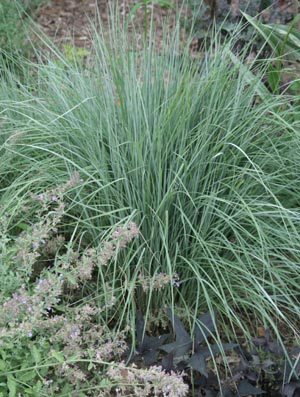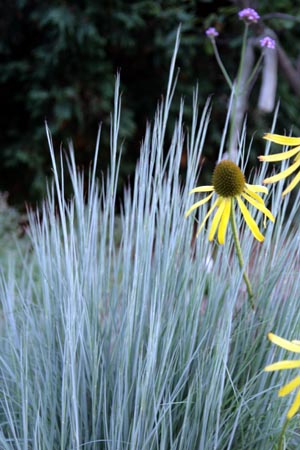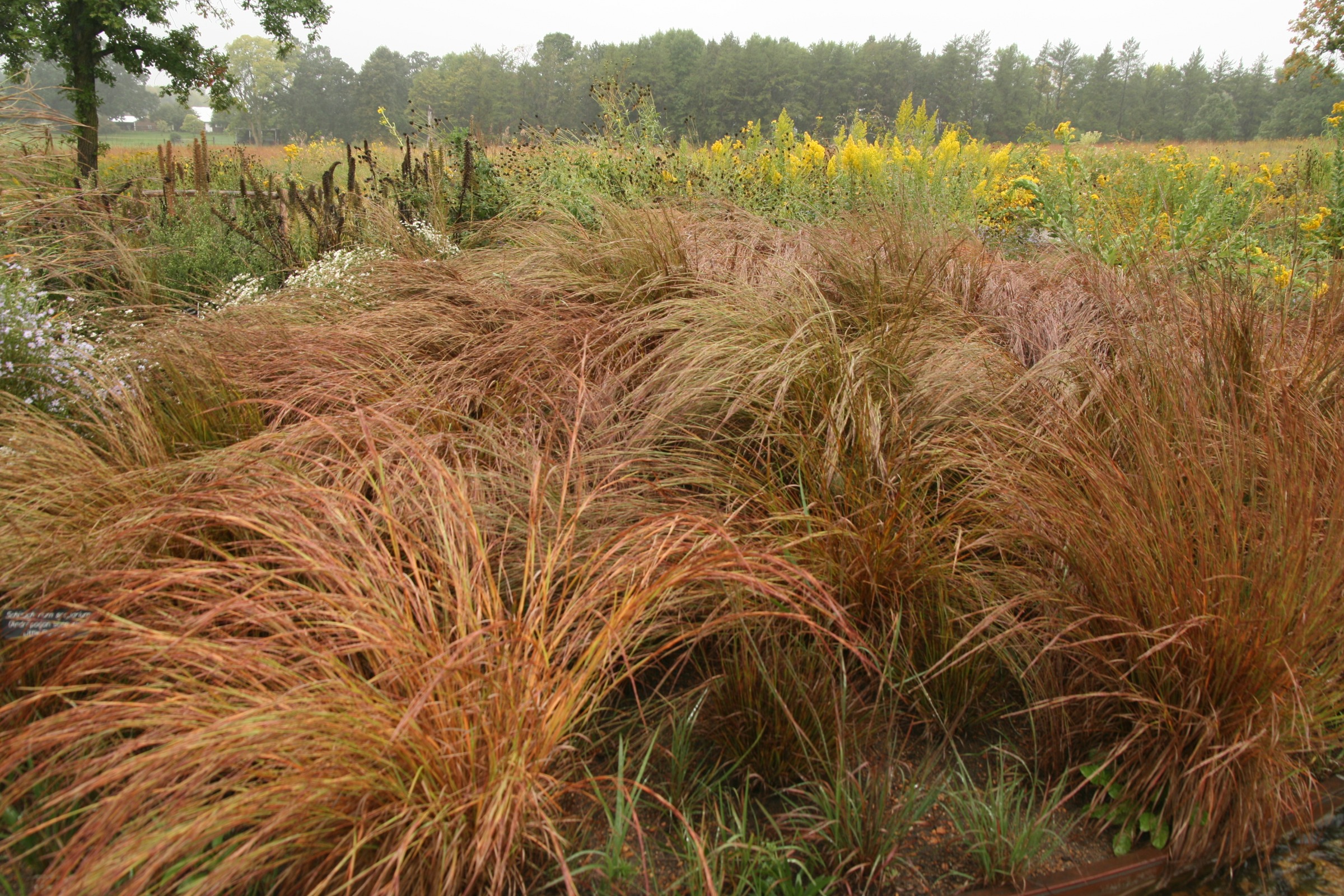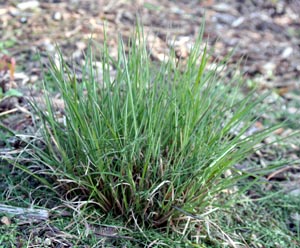
Overview of Little Bluestem
Ornamental grasses continue to increase in popularity, and little bluestem is one of the more popular native species for Wisconsin gardens and landscapes. Little bluestem, Schizachyrium scoparium, is a North American prairie native found throughout the 48 contiguous states, except for the far western, coastal areas. As its name suggests, this perennial has silvery-blue stems (particularly at the base) and leaves, making it an attractive addition to the landscape. This warm-season grass is hardy throughout Wisconsin (USDA Zone 3). Once established, it is a drought-resistant, easy-care addition to the home landscape. Like many other prairie grasses, little bluestem has a deep, extensive root system, allowing it to grow well on poor sites, including dry, upland sites and along hillsides and ridges where it is typically grows naturally.
Little bluestem is also useful for erosion control and provides food and wildlife habitat for songbirds, upland gamebirds, and small mammals. However, it is also readily grazed by rabbits and deer.
Little bluestem clumps grow 1-2 feet high, until late summer when the stems elongate into flowering stems which may reach 5 feet. It has coarse stems and basal leaves. As with all warm-season grasses, it is slow to emerge in spring but continues to grow throughout the summer until the first killing frost. The new shoots are very flat and bluish. Leaves are soft-looking, narrow, and smooth, except at the base next to the sheath where they are often covered with hair. The foliage can be various shades of blue and green, and even with pinkish purple striations, depending on the selection or cultivar. The plants have an upright form, but with their open to spreading habit and fine texture, they are susceptible to lodging (falling over at the base).


The stems are eventually topped in late summer or early fall by 3″ long, fluffy inflorescences that range in color from blue to silvery gold or white. The flowers are scattered in a single cluster, with long hairs creating a white, feathery appearance to the seedheads. The fluffy plumes look great backlit or as part of a cut arrangement. Frost turns the plants a reddish or coppery color that remains through the winter. Allow plants to remain standing through the winter to provide shape, texture, and color in the landscape.
Landscape Use
Little bluestem makes an excellent accent in the border and is ideal for use in drifts in natural settings, prairies, or wild areas that blend into woods, pasture or other natural areas at the edge of the home landscape. Pair it with a dark-leaved Heuchera, such as ‘Purple Petticoats’, for contrast in both color and texture, or play up the purple highlights in the fall by placing it with a clump of autumn crocus (Colchicum) or pink -flowering chrysanthemum or aster. Combine it with perennials including tall sedums like ‘Autumn Joy’, yarrow, rudbeckias, purple or yellow coneflower (Echinacea purpurea and E. paradoxa, respectively), goldenrod and other prairie natives or wildflowers. It makes stunning displays when massed on a large scale, undulating in the breeze. Little bluestem is a great transition plant between gardens and natural fields or meadows.

General Care of Little Bluestem
Little bluestem grows best in full sun. The plant will be taller (and therefore more prone to flopping late in the season) on fertile soils and shorter on dry, infertile sites. Do not fertilize heavily and avoid fertilizing on richer soils. Although it is not recommended for heavy clay, it will grow on clay soils. Watering and overfertilization will promote lodging. Cut the old leaves back to 2-4″ in late winter or early spring.
Propagation of Little Bluestem
Little bluestem can be started from seed (without using any pretreatments) – particularly when used in larger plantings such as meadows or prairies – or from divisions. However, the clumps do not need to be divided very often. This species and most other grasses are best divided and planted in the spring, to allow the full season for their roots to develop. Grasses planted or transplanted in the fall may not establish well enough to survive winter. It should be seeded as early in the spring as possible.

Cultivars of Little Bluestem
There are several varieties and cultivars of little bluestem. Some, such as ‘Aldous’, ‘Blaze’, ‘Camper’, ‘Cimmaron’ and ‘Pastura’, were developed as pasture grasses, so selection was based on productivity, not ornamental value. For landscape use some common cultivars include:
- ‘The Blues’ – the most commonly offered cultivar, with deep blue foliage changing to rich purple and burgundy in the fall. Upright clumps grow about 30-36″ tall and 18″ wide.
- ‘Blaze’ features erect, broom-like clumping growth habit and great winter color. Gray-green summer foliage turns shades of pinkish-orange, reddish-purple, or vivid red in fall. It is very adaptable, growing easily even on clay soils. The clumps grow about 3 feet high and 15″ wide.
- BLUE HEAVEN® (‘MinnBlueA’, plant patent 17310) – from the University of Minnesota, features very upright, broom-like growth and colorful blue-gray foliage summer foliage that becomes purplish red in fall.
- ‘Jazz’ – features silvery blue foliage that transitions to purple to deep bronze in fall. This cultivar is somewhat shorter, reaching 2 to 2.5 feet in height.
- PRAIRIE WINDS® ‘Blue Paradise’ (plant patent 28145) – grows 3 to 3.5 feet tall and 2 feet wide, with blue-purple foliage.
- ‘Smoke Signal’ (plant patent 27433) – Blue-green leaves transition to a smoky purple over the summer and finally change to deep red in fall. Clumps have an upright, columnar form and reach nearly 3 feet in height.
- ‘Standing Ovation’ (plant patent 25202) – Tight, upright growth habit which stays in a uniform clump about 2 to 3 feet high. Blue-green summer leaves are purplish at the base and will turn red to orange in the fall.
– Susan Mahr, University of Wisconsin – Madison
Last Update: Bruce Spangenberg, UW-Madison Extension, 2025





 Aster, Symphyotrichum spp.
Aster, Symphyotrichum spp. Fascinating Fasciation
Fascinating Fasciation Alternatives to Lawn: Groundcovers
Alternatives to Lawn: Groundcovers Marigolds
Marigolds


